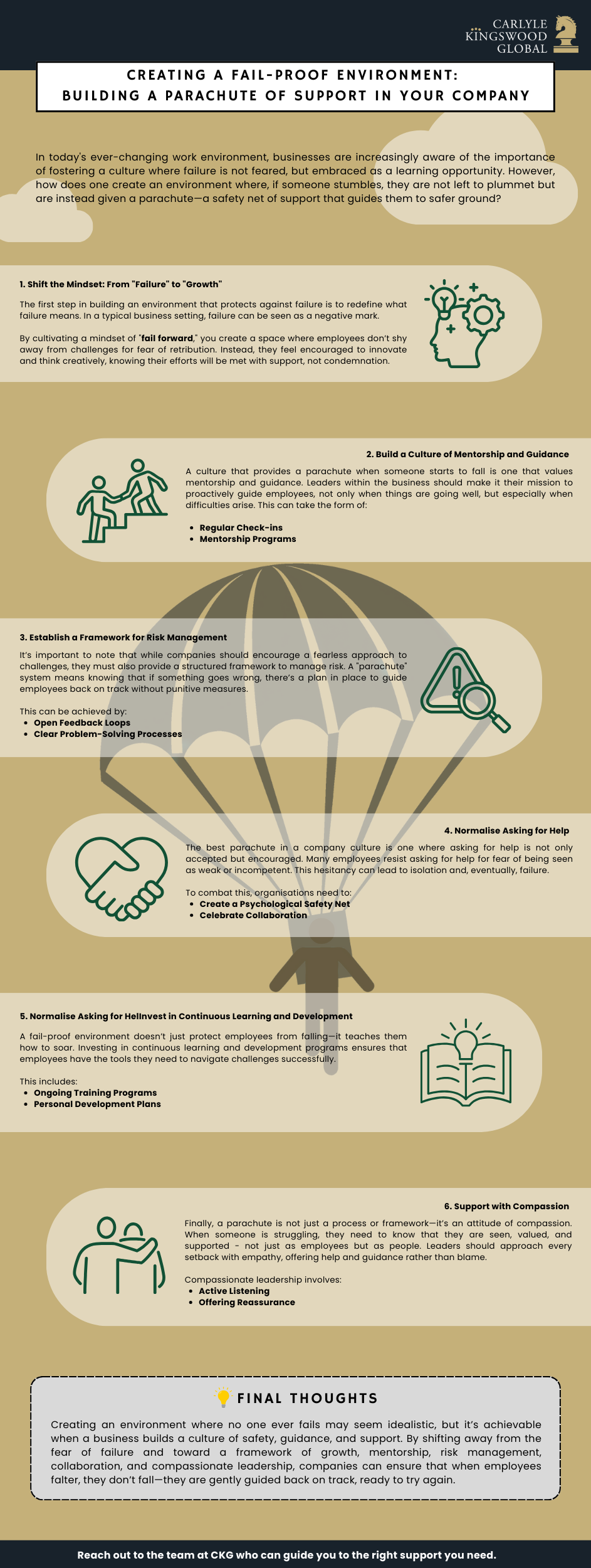Who Is Leading the Ship? People Leave People, Not Jobs
Law firms love to talk about strategy—five-year plans, aggressive growth targets, and market positioning. But all too often, these grand ambitions...
Connecting...
In today's ever-changing work environment, businesses are increasingly aware of the importance of fostering a culture where failure is not feared, but embraced as a learning opportunity. However, how does one create an environment where, if someone stumbles, they are not left to plummet but are instead given a parachute—a safety net of support that guides them to safer ground? This vision of a fail-proof workplace requires intentional design, empathy, and a dedication to continuous development. Here we consider how you can shape an environment where no one truly fails, but is always guided back to success.
The first step in building an environment that protects against failure is to redefine what failure means. In a typical business setting, failure can be seen as a negative mark. But in a progressive, forward-thinking business, failure can be rebranded as an essential step toward growth. Leaders should encourage employees to take calculated risks and make mistakes—provided they learn from them.
By cultivating a mindset of "fail forward," you create a space where employees don’t shy away from challenges for fear of retribution. Instead, they feel encouraged to innovate and think creatively, knowing their efforts will be met with support, not condemnation.
A culture that provides a parachute when someone starts to fall is one that values mentorship and guidance. Leaders within the business should make it their mission to proactively guide employees, not only when things are going well, but especially when difficulties arise. This can take the form of:
Regular Check-ins: A steady dialogue between team members and leaders ensures that no one falls behind without notice. Problems can be addressed early, and support can be extended before a minor mistake turns into a major issue.
Mentorship Programs: Pairing newer employees with experienced mentors fosters a sense of community and support. When an employee faces a challenge, they have someone to turn to who has likely been in their shoes before.
It’s important to note that while companies should encourage a fearless approach to challenges, they must also provide a structured framework to manage risk. A "parachute" system means knowing that if something goes wrong, there’s a plan in place to guide employees back on track without punitive measures.
This can be achieved by:
Open Feedback Loops: Create systems where feedback is frequent, constructive, and solution-oriented. Employees should know exactly where they stand and how they can improve, so they don’t spiral into uncertainty or disengagement.
Clear Problem-Solving Processes: When someone stumbles, a clear and transparent process should exist for resolving the issue. This could involve collaborative problem-solving sessions or extra resources allocated to the team.
The best parachute in a company culture is one where asking for help is not only accepted but encouraged. Many employees resist asking for help for fear of being seen as weak or incompetent. This hesitancy can lead to isolation and, eventually, failure.
To combat this, organisations need to:
Create a Psychological Safety Net: Employees should feel comfortable raising their hands and admitting when they’re struggling, without fearing judgment. It’s essential that leaders model this behaviour by admitting their own challenges and showing vulnerability.
Celebrate Collaboration: Encourage a team-oriented approach where success is collective, and individual contributions blend into a larger goal. Recognising and rewarding collaborative achievements rather than individual heroics helps reinforce the idea that it’s okay to rely on others for support.
A fail-proof environment doesn’t just protect employees from falling—it teaches them how to soar. Investing in continuous learning and development programs ensures that employees have the tools they need to navigate challenges successfully. This includes:
Ongoing Training Programs: Regular workshops and skill-building sessions help employees stay sharp and confident. When they face obstacles, they can lean on this training to guide them.
Personal Development Plans: Each employee should have a tailored development plan that outlines their growth trajectory. When employees have a clear sense of their goals and how they can improve, they are more likely to see challenges as stepping stones rather than stumbling blocks.
Finally, a parachute is not just a process or framework—it’s an attitude of compassion. When someone is struggling, they need to know that they are seen, valued, and supported - not just as employees but as people. Leaders should approach every setback with empathy, offering help and guidance rather than blame.
Compassionate leadership involves:
Active Listening: When an employee brings up an issue, listen without interrupting or immediately offering solutions. Understand where they’re coming from before taking action.
Offering Reassurance: Sometimes, employees need to hear that it’s okay to make mistakes. Reassuring them that they’re not alone and that the business values their contributions, even during tough times, can make all the difference.
Creating an environment where no one ever fails may seem idealistic, but it’s achievable when a business builds a culture of safety, guidance, and support. By shifting away from the fear of failure and toward a framework of growth, mentorship, risk management, collaboration, and compassionate leadership, companies can ensure that when employees falter, they don’t fall—they are gently guided back on track, ready to try again.
Reach out to our team, who can help guide you to the right support you need.
